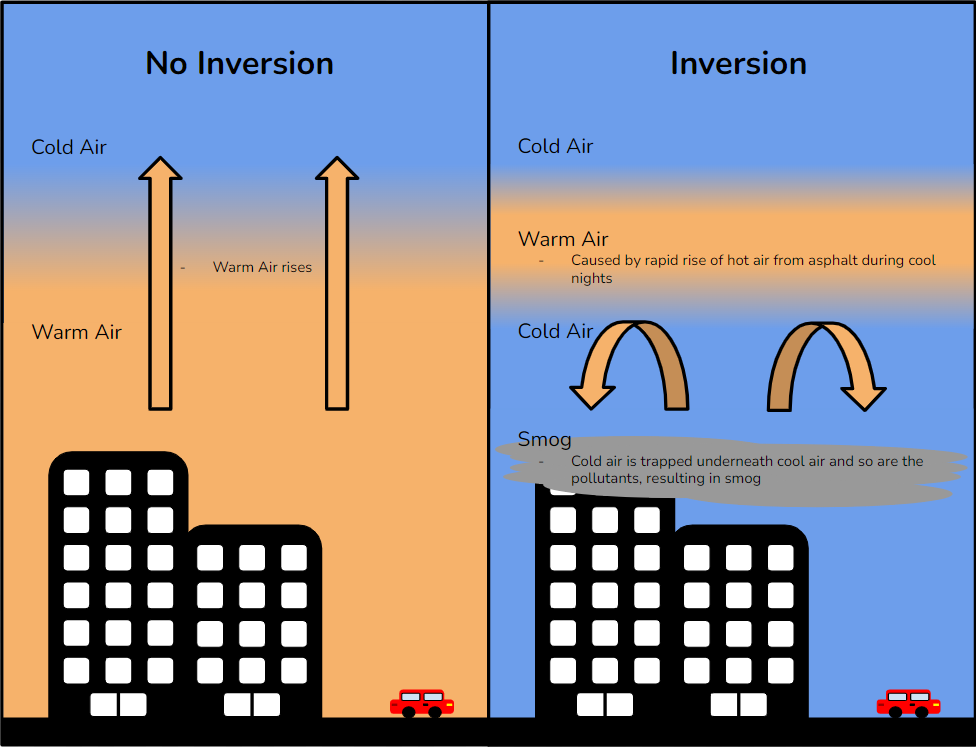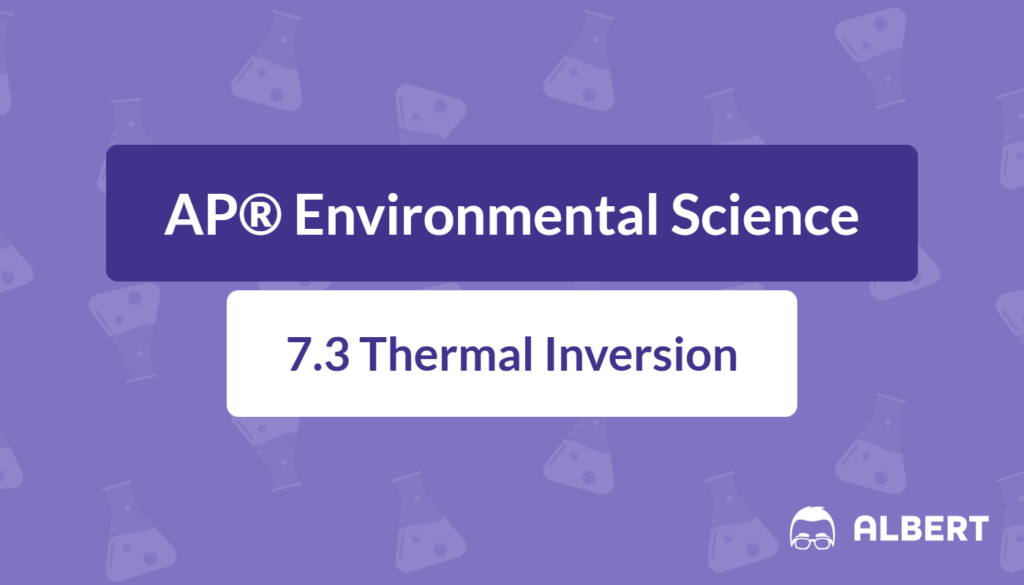What We Review
Introduction
Thermal inversion plays a significant role in air pollution episodes. It affects how pollutants like smog and particulates are dispersed or trapped near the ground. Typically, air temperature decreases as altitude increases, enabling pollutants to rise and disperse. However, when thermal inversion occurs, this temperature pattern reverses, and a layer of warmer air settles above cooler air near the surface.
Therefore, pollution released at ground level remains trapped and concentrates, often creating health and environmental challenges for urban areas. This article breaks down the causes and effects of thermal inversion, using real-world examples to show how such events unfold. Additionally, it outlines ways governments, communities, and individuals can manage or prevent severe air quality issues related to thermal inversion.
What Is Thermal Inversion?
Thermal inversion is a situation in the troposphere where a warmer layer of air sits on top of cooler air below. Under normal conditions, temperature generally decreases with height. This process is sometimes called the environmental lapse rate. A common approximate lapse rate is about 6.5,^\circ\text{C} of cooling per 1000,\text{m} of atmospheric ascent. In a typical atmosphere, this normal temperature gradient allows warm air near the surface to rise, taking pollutants upward.
However, during a thermal inversion, this gradient becomes inverted. Cool, dense air settles below a layer of warmer air, preventing the cool air from rising. Consequently, smog and other pollutants accumulate near the ground. When combined with factors like calm winds and reduced air mixing, pollutants linger in one place far longer than they normally would.
How Does Thermal Inversion Occur?
Thermal inversions often arise under specific weather conditions that favor stable atmospheric layers. Several factors contribute to their formation:
- Nighttime Cooling: During clear nights, the Earth’s surface loses heat quickly through radiation. The air in immediate contact with the ground cools faster than air at higher altitudes.
- Calm Weather: Without wind, there is minimal mixing of air near the ground. Consequently, the cooler air stays at the surface while warmer air sits above it.
- Geographical Features: Valleys surrounded by mountains frequently experience thermal inversions. Cool air tends to pool in low-lying areas, and the surrounding high terrain traps the cold layer in place.
- Persistent High Pressure: Areas under a high-pressure system often have descending air that warms as it sinks. When it settles over cooler air, an inversion layer can form.
Step-by-Step Formation
- As night falls, the ground radiates heat, causing the surface air to cool.
- Because cool air is denser, it remains at ground level.
- A warmer air mass may move in aloft or form due to subsidence (sinking air) under high pressure.
- Transition words like “therefore” and “furthermore” often appear in explanations of the stalled air, highlighting the cause-and-effect sequence. In essence, the warmer layer “caps” the colder layer, inhibiting vertical mixing.
Thermal inversions also occur in industrial settings where heavy pollution is likely. Power plants, factories, and dense traffic contribute to higher levels of smog or particulate matter that become more noticeable during inversions.
The Relationship Between Thermal Inversion and Pollution
Thermal inversion directly impacts local air quality. Because the warm-air cap hinders upward movement, pollutants get trapped in the cooler air below. This phenomenon increases the concentration of substances such as:
- Smog (a blend of smoke and fog, often containing ground-level ozone and other chemicals)
- Particulate matter (solid or liquid particles suspended in the air, commonly known as PM2.5 and PM10)
- Other pollutants like sulfur dioxide, nitrogen oxides, and volatile organic compounds (VOCs)

Moreover, when sunlight interacts with trapped chemicals, secondary pollutants can form. For example, ground-level ozone, a major component of smog, can increase under stagnant air conditions. In highly populated regions, the public health impact grows more serious. Individuals with respiratory conditions often experience worsened symptoms.
Therefore, thermal inversion events become a focus area in AP® Environmental Science. Understanding how these events trap pollutants helps describe thermal inversions and their relationship with pollution. The slower dispersion rate makes air quality monitoring and pollution control more crucial than ever.
Real-World Examples of Thermal Inversion Events
Certain locations are famous for repeated thermal inversions. Examples include Los Angeles, California, which experiences frequent smog episodes due to a combination of vehicle emissions and surrounding mountain ranges. However, other historical events illustrate dramatic consequences:
- The Great Smog of London (1952): A high-pressure system created an inversion over London. As coal smoke built up, visibility dropped dramatically, and thousands of residents suffered health complications. This incident eventually led to stricter clean air legislation in the United Kingdom.
- Donora Smog (1948): An inversion trapped industrial emissions from a steel mill in Donora, Pennsylvania, resulting in severe respiratory problems. This event heightened awareness of the dangers of unregulated industrial pollution.
- Mexico City Smog: Situated in a high basin surrounded by mountains, Mexico City frequently experiences inversions that exacerbate vehicle and industrial emissions.
Step-by-Step Breakdown of an Event
Take the Donora Smog as an example:
- A weather system created calm weather and reduced air movement.
- Cool air near the surface stayed trapped underneath warmer air.
- Industrial sources released sulfur dioxide and particulate matter.
- Without the usual mixing, pollutants accumulated.
- Local residents experienced difficulty breathing and other health issues.
- Public outcry led to environmental research and early clean air policies.
These case studies highlight the seriousness of thermal inversions and reinforce why students learn about them in connection to strategies for improving air quality.
Prevention and Management of Thermal Inversion Effects
Although thermal inversions are natural occurrences, strategies exist to minimize the harm they cause:
- Emission Controls: Reducing pollutants at their source is critical. Installing scrubbers on power plant smokestacks or using catalytic converters in vehicles helps lessen the concentration of smog-forming chemicals.
- Clean Energy Initiatives: Encouraging renewable energy sources, such as solar and wind, decreases reliance on fossil fuels. Cities where renewable energy usage is high often show lower pollution levels during inversions.
- Monitoring Air Quality: Agencies like the Environmental Protection Agency (EPA) use air quality indices to alert the public about unhealthy conditions. Temporarily limiting heavy traffic or factory output on days of poor dispersion can help.
- Urban Planning: Designing cities with efficient public transportation and widespread green spaces can alleviate some pollution problems. Trees and vegetation help filter certain pollutants and reduce the heat island effect.
- Policy Enforcement: Strong legislation, such as the Clean Air Act in the United States, drives systematic changes through emissions standards and regular air monitoring.
Therefore, multi-level approaches—ranging from individual actions (like carpooling) to international agreements—are necessary for long-term success.
Key Vocabulary
- Thermal Inversion: A meteorological event in which a layer of warm air traps cooler air beneath it, reversing the normal temperature gradient.
- Pollutants: Harmful substances that contaminate the air, often produced by human activities like burning fossil fuels.
- Smog: A type of intense air pollution that forms when emissions react in the presence of sunlight, creating ground-level ozone and particulates.
- Particulates: Tiny solid or liquid particles suspended in the air, often referred to as PM2.5 or PM10, which can harm human health and the environment.
- Temperature Gradient: The rate at which temperature changes with altitude, typically decreasing as altitude increases under normal conditions.
Conclusion
Thermal inversion remains a central concept in AP® Environmental Science because it reveals how atmospheric changes can profoundly impact air quality. Inversion events trap pollutants like smog and particulates near the ground, amplifying health risks and environmental damage. Historical examples such as the Great Smog of London underscore the significance of understanding this phenomenon and developing strategies to manage its impact.
By recognizing conditions that lead to thermal inversions and encouraging responsible energy use, communities can devise policies and actions that mitigate poor air quality. Overall, an awareness of thermal inversions reinforces larger lessons about humanity’s responsibility to balance development with environmental stewardship.
Sharpen Your Skills for AP® Environmental Science
Are you preparing for the AP® Environmental Science test? We’ve got you covered! Try our review articles designed to help you confidently tackle real-world AP® Environmental Science problems. You’ll find everything you need to succeed, from quick tips to detailed strategies. Start exploring now!
- AP® Environmental Science: 6.13 Review
- AP® Environmental Science: 7.1 Review
- AP® Environmental Science: 7.2 Review
Need help preparing for your AP® Environmental Science exam?
Albert has hundreds of AP® Environmental Science practice questions, free response, and full-length practice tests to try out.








